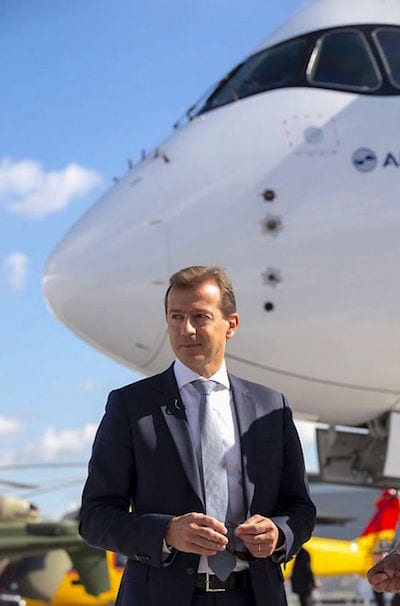
Airbus CEO Guillaume Faury discussed the long-term benefits of the company’s investments in digitalization during the company’s July 30 half-year 2020 earnings call. (Airbus)
Airbus CEO Guillaume Faury was asked a key question about the French aerospace manufacturer’s investment in digital design initiatives during the company’s half-year 2020 results call July 30 that featured an exchange between business and financial principles of the commercial aviation industry, versus developing next generation aircraft and manufacturing production systems.
The consolidated net loss experienced by Airbus during the first six months of the year amounted to €1.9 billion compared to the same period in 2019, under the impact of order cancellations related to COVID-19, delivery delays and adjustments to manufacturing operations. Research and development expenses – which include the company’s investments in digital design tools and services – remained relatively unchanged and Faury expressed no desire to lower R&D investments in the near future.
Among the first analyst questions asked of Faury was focused specifically on when Airbus expects to see some type of measurable improvement in a financial metric or data point as a result of their investment in digital transformation technologies.
The analyst asked, “Should we expect these investments to be benefiting potentially margins and cash flow from 2021 or 2022?”
The digitalization investments being referred to by the analyst are known Airbus’ “Digital Design, Manufacturing & Services (DDMS)” program, described on the company’s website as “a digital-first approach to the way aerospace products are designed, manufactured and operated.” The second sentence in the DDMS overview hints at the analyst’s point: how can one measure the financial benefits of moving from paper-based/analogue methods of manufacturing work orders and record-keeping between Airbus, suppliers and airlines to a supply chain ecosystem that is completely digital?
“Our DDMS programme focuses on digital methods and tools for end-to-end business process that ensure we can reduce costs and time to market for our products,” the description says.
Faury, who is in his second year at Airbus as the CEO after serving in positions ranging from engineering to flight testing and manufacturing, replied by explaining that there would be no short term measurable financial benefit from digitalization. Instead, he argued that the long-term benefits of digital transformation on their overall production operations and the technologies they will be able to incorporate in future aircraft outweigh short term financial goals.
“Digital serves the long-term perspective, which is the next generation of planes, the new development of the new systems,” Faury said. “It is not targeting short term savings on R&T or R&D. It is by far more designed to produce planes for the next generation, which will be modern planes and production systems having a much different efficiency when it comes to the overall performance of the program.”
Among the programs and initiatives listed as DDMS projects are the A321XLR first introduced last year and the Future Combat Air System (FCAS), currently the largest European defense technology initiative managed by France, Germany and Spain to develop sixth generation fighter jet technologies and fully automated remote air platforms. Last year, Airbus Defense and Space adopted a set of digital design tools and services from ANSYS to develop embedded flight control software for FCAS.

Airbus R&D investment and adoption of new digital technologies and processes, such as a COVID-19 inspired “e-delivery” program introduced in April. (Airbus)
Enablers for the Airbus DDMS program also include their “Industry 4.0” initiatives, with advanced analytics, artificial intelligence and quantum technologies all mentioned as topical areas. Faury credits the ongoing digitalization of their entire manufacturing ecosystem for their ability to continue their production facilities and manage the small number of deliveries that they were able to under COVID-19 conditions.
“Don’t expect on the short term to have signs of savings from this project. It’s more of an investment that we do in the course of the four or five years to come. But these are investments which are game changing a bit like what we do on environment with green technologies that have a potential to really transform what aviation will look like in the next decade,” he said.
Recently, Airbus completed a project focused on autonomous flight trials using specialized cameras and flight management software to enable vision-based takeoffs and landings. CTO Grazia Vittadini has also been a major proponent of using digitalization to help improve carbon emissions performance for their next generation aircraft.
Beyond the benefits of digital design, Airbus confirmed there would be no changes to any fixed costs for the remainder of the year, and the same policy will remain effective in 2021. Through the end of June, a total of 145 aircraft were undeliverable due to COVID-19 and the production rate for the A350 has been reduced to five per month for the foreseeable future.
Faury said he remains optimistic on the long-term outlook for the commercial market with at least two to three years before he expects to see a return to pre-COVID-19 demand for airliners.
“We look at the long term perspective when COVID is behind us and we see a very very strong market for demand, and in some cases even bigger because there has been this one, two, three, four or five years of a drop that we have seen with COVID-19,” Faury said.
Through June 30, the Airbus order backlog stands at 6,168, the majority of which are single-aisle A320 family aircraft.